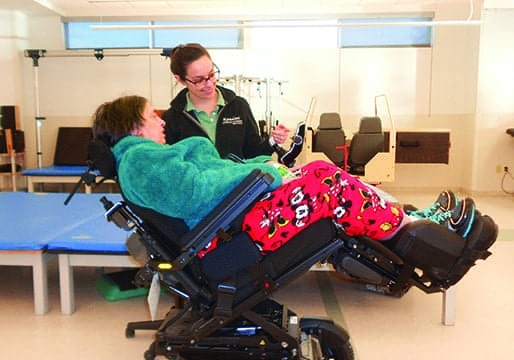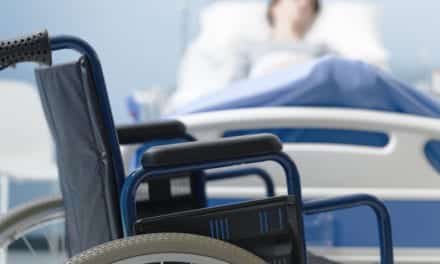
Michelle V. Agostini, PT, DPT, advises client Rosalyn Holt about power seat functions. Educating clients about these features and functions is best when done with each wheelchair trialed in multiple settings to reinforce benefits of power tilt, recline, legrests, and seat elevate.
by Michelle V. Agostini, PT, DPT, and Katherine Ackerman, PT, DPT, ATP
The large market for wheelchair seating and positioning products can be overwhelming to the consumer and professional, and the multitude of options can lead to inappropriate or poorly fitting seating systems. It is therefore imperative for qualified individuals specializing in wheelchair seating and positioning to be involved in the seating process to optimize care and recommendations.
Kessler Institute for Rehabilitation, West Orange, NJ, has both outpatient and inpatient wheelchair clinics with qualified wheelchair seating and mobility team members. A variety of needs are addressed during inpatient and outpatient seating clinics, including issues related to individuals affected by brain injuries, spinal cord injuries, amputations, congenital disorders, and neurodegenerative diseases. Clinicians have the unique opportunity to recommend wheelchair and seating products at an inpatient level, then follow the client through the continuum of care.
The wheelchair selection process can be broken down to eight major components: referral, assessment, equipment recommendation and selection, funding and procurement, product preparation, fitting, follow-up, and outcome measurement.1 In this article, referral, assessment, equipment recommendation and selection, fitting, and follow-up are discussed as they relate to seating system selection.
Referral and Assessment
Recommendation from the attending physician is commonly the start of a seating evaluation. Seating needs are reassessed throughout the inpatient level, and recommendations are completed prior to discharge when possible. In the outpatient clinic, the client first receives a doctor’s referral for a seating evaluation and, if determined a candidate for a custom seating system, an evaluation is initiated.
As part of the assessment and evaluation, clients are issued detailed home modification questionnaires regarding the client’s home setting, including all entrances into the home, bedroom setup, bathroom setup, and dimensions for all doorways. Clinicians frequently request photographs of the home for visualization. This facilitates accurate recommendations for any modifications required to allow adequate access for the client in the home. Information regarding current or planned means of transport (such as accessible vehicles) is also requested. Upon completion of the form, the therapist provides detailed recommendations in line with American Disability Act guidelines. This ensures access to all environments is considered when making recommendations for a wheelchair or seating system.
Both at inpatient and outpatient levels, a qualified individual completes a mat evaluation as part of the initial evaluation. The mat evaluation analyzes the effects of tone, body habitus, reflexes, and various anatomical measurements both in supine and sitting on posture and alignment. It is important to note any postural abnormalities as flexible, difficult to correct, or fixed in nature to facilitate appropriate selection of seating components. Once the mat evaluation is completed, the team then selects several products for trial to meet the individual’s specific needs and offers either accommodation or correction as necessary. Assessing a client’s tolerance to corrections and accommodations is important; noting the influence of tone, posturing, and reflexes ensures the seating system meets the individual’s needs throughout the day without any adverse reaction.
Equipment Trial and Simulation Impact of Wheelchair Systems
Selection of an appropriate seating system that meets the individual’s postural needs while maximizing safety and promoting independence is imperative. If an appropriate seating system is not selected, the individual’s mobility, sitting tolerance, ability to complete activities of daily living, and access to electronic aids of daily living may be impaired. This, in turn, ultimately impacts the client’s independence and quality of life in a negative way. The facility has a wide range of specialty wheelchairs available to trial, including power, power with alternative drive systems, power assist, ultra-light weight, and tilt-in-space wheelchairs. If an appropriate wheelchair is not available, the team works with supplier and manufacturer representatives to obtain “demo” products. Adaptations and modifications to the selected seating system during client trials optimize the individual’s positioning and potential for independent function.
External Support Systems
There is a multitude of options and alternatives available when determining an optimal seating system setup, ranging from prefabricated modifications and parts to custom components and molded supports. These endless options make it especially important to know personal strengths as a clinician, and reach out to other qualified individuals as needed. The members of the seating team at Kessler work together as well as with suppliers and manufacturers to optimize each client’s seating system.
Selection of a proper cushion maximizes pressure distribution, minimizes the risk of pressure injury, improves alignment, and maximizes a client’s sitting tolerance for upright sitting.2 There are many categories of cushions available, all of which have advantages and disadvantages based on the various properties as well as the needs of the client. The cushion materials include various combinations of gel, foam, and air.3 Additional supports, customizations, or modifications recommended should be trialed. An interface pressure mapping system is frequently utilized to determine an optimal seating surface. This allows clinicians the ability to objectively quantify the distribution of pressure over bony prominences as well as envelopment and immersion of each cushion. Additional postural supports such as trunk lateral supports or thigh guides may be warranted to maximize a client’s postural alignment and pressure distribution across the seating surface. The output from the sensor, clinical judgment, and client’s report all contribute to the selection of an optimal cushion. These include alternative cushion covers, hip adductor wedges, pelvic obliquity build-ups, and fluid supplement packs. These tools allow for further adaptation of the client’s body habitus and postural abnormalities.
A multitude of prefabricated back supports are available with a degree of adjustability, contour/support, and overall design. Details gained during the mat evaluation and patient assessment regarding anatomical measurements, and overall alignment are used to select appropriate back support. Trialing the selected back supports during a seated assessment as well as throughout equipment trials on simulated seating systems allows the clinician and the client to evaluate the effectiveness of the support on positioning, sitting tolerance, postural abnormalities, and pressure distribution. When accommodation of a client’s postural needs is not possible with a prefabricated back support, custom backs are created with guidance from manufacturers and suppliers.
Use of Power Seat Functions
Power seat functions improve mobility, access to environment, and independence for many clients. Power tilt and recline provide independent adjustment of back and hip angle, and have multiple medical and functional benefits such a maximizing pressure re-distribution and postural support, which reduces the risk of skin breakdown. Power tilt and recline also increases ease with repositioning and assists with appropriate positioning for bowel/bladder management. Use of recline alone can facilitate poor alignment; the addition of power tilt reduces shear and maintains pelvic position. Tilt and recline can also be used for blood pressure management. For clients with decreased activity tolerance, the power tilt and recline allow for multiple changes in position for improved sleeping and/or rest breaks. With this ability to rest in the wheelchair, less transfers are required throughout the day.
Power articulating elevating legrests provide leg extension while elevating. This feature on power wheelchairs improves circulation and reduces risk for edema when combined with the power tilt and recline. The power articulating legrests can also reduce risk for contracture, accommodate for knee range of motion deficits, or assist with pain management. The articulating legrests increase access to environment by providing proper leg positioning while in the seating system, such as increasing ground clearance to navigate thresholds and slopes.
A power adjustable seat height system raises and lowers the client in the seated position, without changing the seat angle. This provides changes in vertical position and access to the environment such as cupboards, microwaves, and dressers. Power wheelchairs without power adjustable seat height offer limited vertical height and reach. This results in decreased independence with functional mobility. Use of the power adjustable seat height system facilitates independent transfers from the wheelchair, and decreases overhead/shoulder reaching. This in turn reduces the client’s risk for neck and shoulder pain and injury.
Other adaptations used to maximize support, positioning, and pressure distribution include upper extremity supports (such as lap trays or arm troughs), pelvic supports, chest supports, and components to improve lower extremity positioning. Each is carefully selected and trialed to best help the client attain the optimal seating system.
Final Recommendation and Follow-Up
Once the mat evaluation, pressure mapping, and simulated seating trials are completed, the client and wheelchair specialists determine final recommendations for the custom seating system. There is input from a certified assistive technology professional, the clinician, the client, and family members. The client is consistently at the center of the process, with input from the clinician and supplier as warranted. At the vendor meeting, the client has input into all specifications of the system. Positioning the client in the mock seating system is ideal, as this allows demonstration of working components and those that need modification. Including family members or caregivers, or both, allows for full consideration of the client’s environment in the home and community. It also allows for discussion regarding various limitations, such as funding, environmental access, or functional restraint.
Seating goals are re-evaluated at the outpatient level, updating them based on postural changes, functional progress, environmental restraints with input from the client’s current outpatient therapists. Follow up continues at the outpatient wheelchair clinic to facilitate adjustments and modifications as ongoing care. This continued support helps maintain seating systems safely and effectively. RM
Michelle V. Agostini, PT, DPT, is a senior physical therapist at Kessler Institute for Rehabilitation, West Orange, NJ.
Katherine Ackerman, PT, DPT, ATP, is a senior physical therapist at Kessler Institute for Rehabilitation, specializing in spinal cord injury, brain injury and stroke care since 2012. She is a senior member of Kessler’s inpatient wheelchair seating and mobility team. For more information, contact [email protected].
References
1. Arlege S, Armstrong W, Babinec M, et al. RESNA Wheelchair Service Provision Guide. 2011:3.
2. Minkel J. Seating and mobility considerations for people with spinal cord injury. Physical Therapy. 2000;80(7):701-709.
3. Sonenblum SE, Vonk TE, Janssen TW, Sprigle SH. Effects of wheelchair cushions and pressure relief maneuvers on ischial interface pressure and blood flow in people with spinal cord injury. Arch Phys Med Rehabil. 2014;95:1350-1357.



